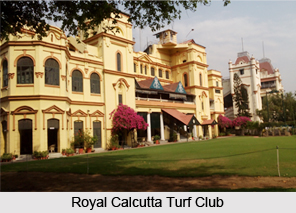 History of Royal Calcutta Turf Club began with the establishment of the Club on 20th February 1847.
History of Royal Calcutta Turf Club began with the establishment of the Club on 20th February 1847.
Purpose of Royal Calcutta Turf Club
The purpose of Royal Calcutta Turf Club from the establishment of the Club by the British Government in India was to regulate all aspects of horse racing in Kolkata. The members of the club were elected by ballot. A five-person committee ran the club, and five stewards ran the races. In 1856 the Calcutta Derby was replaced by the Viceroy`s Cup. Spectators of this race were admitted by invitation only. In 1860 Lord Ulrich Browne came into the Calcutta racing scene, which he would dominate. He was responsible for redrafting the racing rules and revising the weight-for-age scale. In 1879 the first Monsoon Meeting was held on a specially constructed course inside the main flat course. In 1880 public interest in racing grew when races started to be held in the afternoons, and new stands were built.
Royal Calcutta Turf Club in 1800 to 1900
Royal Calcutta Turf Club came to have the same authority as the Jockey Club in England, the arbiter on matters concerning the rules of racing. Thus a notice for a January 1863 race meeting at Muzaffarpur showed it was run under Calcutta Turf Club rules. In 1883 the British House of Lords discussed a case in which Surgeon-Major Thornburn had been accused by the Lucknow Race Course of causing a pony to be pulled, and the Calcutta Turf Club upheld that decision. A court of inquiry looked into the matter, and the Commander-in-Chief of India held that the evidence confirmed the decision of the Calcutta racing club. Thorburn was refused a court martial and was forced to return to England and to retire. By 1899 Royal Calcutta Turf Club was the authority for rules at all of the 52 courses in the subcontinent and Burma apart from Mumbai, Pune, Karachi and Kolhapur, which were under the jurisdiction of Bombay.
Royal Calcutta Turf Club and the Indians
In the 1880s the Calcutta Turf Club held polo matches, open to both Indians and Europeans. The club continues to hold polo matches on the grounds in the middle of the racecourse. From 1886 to 1897 Sir William McPherson headed the racing organization. He upgraded the rules of racing. He also struck an agreement with the Bombay Turf Authorities under which any course in India that held races under the rules had to submit to the authority of Calcutta or Bombay. Sir William introduced various other changes. Jockeys could not bet and professional handicappers were introduced.
Introduction of Steeple Chasing
Steeple Chasing was brought under the jurisdiction of the Calcutta Turf Club in 1888. The first Grand National in India was run in 1895 at the course at Tollygunj. Steeple chasing was one of the main events in the racing season.
Related Articles
Capital Cities of India
Kolkata
History of Kolkata
Kolkata, Indian City, West Bengal
Culture of Kolkata
Birla Planetarium, Kolkata
Economy of Kolkata
West Bengal, Indian State
British Monuments in Kolkata
Monuments in Kolkata, West Bengal Monuments
British Monuments in India
Monuments of West Bengal
Architectural Developments of Calcutta during British Rule
Early British Architectural Design in India
British Military Architecture in India
Art and Architecture during British Rule in India
History of Indian Telecommunications
Impact of British Rule in India
Fort William, Kolkata
Battle of Plassey
Sports in Kolkata



















